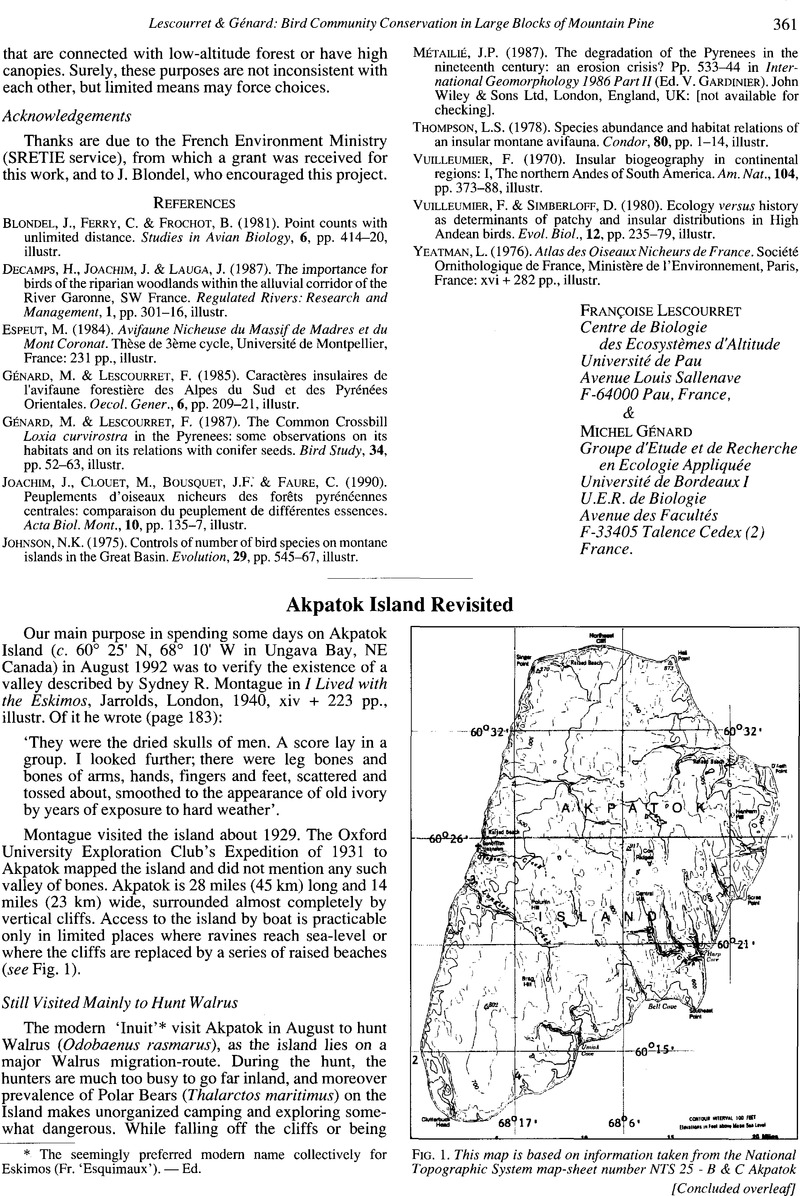Article contents
Akpatok Island Revisited
Published online by Cambridge University Press: 24 August 2009
Abstract

- Type
- Short Communications & Reports
- Information
- Copyright
- Copyright © Foundation for Environmental Conservation 1992
References
* The seemingly preferred modern name collectively for Eskimos (Fr. ‘Esquimaux’). — Ed.
* The members of our party were Professor Irvin Roy Hentzel, Gene Steiner, Patricia Steiner, Robert Hentzel, Stuart Nelson, Dr Normand Tremblay, and Jusipi Keleutak (guide). The outfitter was Bob Deer of Quartaq, Canada. We spent 8–11 August 1992 on the Island.
† Probably the local subspecies of the Arctic Fox (Alopex lagopus ungavus). — Ed.
§ Presumably the highly polymorphic Common Scurvy-grass (Cochlearia officinalis s.l.) but just possibly a member of the Sorrel Family, namely Mountain Sorrel (Oxyria digyna), which is also common on sea-shores practically throughout the Canadian Arctic Archipelago though less favoured by manuring than Scurvy-grass (belonging to the Mustard and Cabbage Family) — cf. Polunin, N., ‘The Flora of Akpatok Island, Hudson Strait’, Journal of Botany, LXXII, pp. 197–204, 1934Google Scholar; ‘The vegetation of Akpatok Island, Part I’, Journal of Ecology, XXII, pp. 337–95, illustr., 1934Google Scholar; ibid. ‘Part II’, Journal of Ecology, XXIII, pp. 161–209, illustr., 1935Google Scholar; Botany of The Canadian Eastern Arctic, Part I: Pteridophyta and Spermatophyta, Canada: Department of Mines and Resources, National Museum Bulletin Nr 92, vi + 408 pp., illustr. + folding map, 1940; ibid. Part III: Vegetation and Ecology, Canada: Department of Mines and Resources, National Museum Bulletin Nr 104, viii + 304 pp., illustr. + folding map, 1948; Circumpolar Arctic Flora, Clarendon Press, Oxford, England, UK. xxviii + 514 pp., c. 1,000 illustrs, 1959; etc. —Ed.
* Such swamps are sometimes only short-lived in this porous limestone terrain, though the dependent vegetation seemed able to withstand such vicissitudes. Thus although I have had, reluctantly but almost chronically, to answer Professor Hentzel's very natural questions rather negatively by saying that I could not trust my memory about details after more than sixty years, I do distinctly remember noting, somewhere in the southern half of Akpatok, a group of shallow small lakes — looking rather like the more northerly ‘Whole New Lake District’ shown in the lower photograph facing page 170 of my Isle of Auks — that had largely disappeared when I revisited the area a few weeks later. — Ed.
- 2
- Cited by




